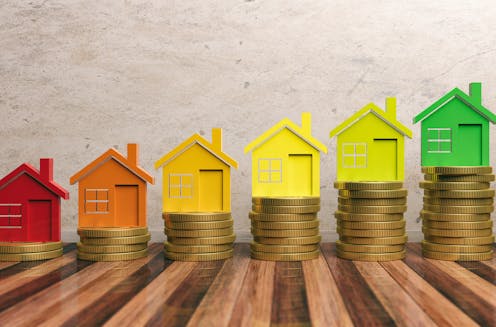How investing in green buildings, including cheaper home loans, is a win for banks, people and our planet
- Written by The Conversation

Australia is facing dual crises: increasing climate change risks and soaring housing costs. Financial institutions have a crucial role to play in funding and promoting solutions to these challenges.
A recent United Nations Environment Programme report, Banking on Green Buildings, proposes ways to promote sustainable buildings in line with both economic and environmental goals. Suggested options include green bonds and green mortgages for developing and renovating buildings to be sustainable.
Banks have the power to revolutionise how we fund construction. Directing investment into green buildings means future houses can be affordable, sustainable and resilient to climate change.
Our buildings account for around 19% of total energy use and 18% of direct carbon emissions in Australia.
How does this help with housing costs?
Rising costs and a lack of affordable choices are putting immense pressure on Australia’s communities and housing sector. Soaring energy bills have driven up the cost of living, especially for low-income households.
Modern construction methods and green buildings provide an answer since they are more efficient and use less energy. So smart green building strategies can produce more affordable homes for Australians that are cheaper to run.
By reducing living costs, green homes also reduce mortgage default risk. That’s one reason banks in some parts of the world already promote their benefits.
Various UK lenders offer green mortgages with lower interest rates to buyers of energy-efficient new homes. A European Commission-funded project has also provided green mortgages.
Green homes increase resilience
Australia faces increasing risk from natural hazards including bushfires, floods and extreme heatwaves as a result of climate change. Australian households paid an average of A$888 a year in direct costs because of extreme weather events over the ten years to 2022. This figure is expected to exceed $2,500 a year (in 2022 dollar value) by 2050.
Energy-efficient and sustainably built buildings are more resilient to climate change impacts such as extreme heat. They lower long-term risk for investors and households by improving comfort and safety during extreme weather.
Banking programs that give priority to energy-efficient designs and materials have a dual effect: they reduce environmental impacts and strengthen resilience to climate change.
Who does this in Australia?
Green building loans enable financial institutions to develop and expand their product offerings.
NAB’s Green Finance for Commercial Real Estate program is an initiative that increases commercial buildings’ climate resilience. It includes financing for developing green buildings and retrofitting buildings to greatly reduce energy use and emissions.
The Sustainable Australia Fund’s offer of $100 million in green loans to business is another program that helps make buildings more sustainable. Eligible upgrades include renewable energy and battery storage, building insulation and electric vehicle charging stations. Owners are advised on the emissions profiles of their properties and possible improvements.
Bank Australia’s Clean Energy Home Loan is an example in the housing sector. The bank offers lower rates for home owners to make their homes more energy-efficient and environmentally friendly.
Global examples of success
Financial institutions worldwide have benefited from including sustainable construction investments in their portfolios.
A 2023 International Finance Corporation report, Building Green, shows green construction could be a US$1.5 trillion investment opportunity in emerging markets over the next decade.
Global demand for investments in climate-resilient infrastructure is already high, as green bond issues show. Banks issue these bonds to borrow money from investors. The banks then use those funds to provide loans for environmentally friendly purposes.
In the past two months, First Abu Dhabi Bank raised US$600 million and Commercial Bank of Dubai raised US$500 million by issuing green bonds.
The success of European property consultancy CFP Green Buildings demonstrates the scalability of such programs. It has grown from greening 3,000 buildings per year to over 3.5 million buildings per year.
CFP has now partnered with CommBank to provide comparable tools in Australia to assess commercial buildings, identify ways to improve their sustainability and estimate costs.
The Japan Bank for International Cooperation’s green bonds issues, totalling more than US$1.5 billion over the past four years, is another example of the robust global demand. Funded projects involve renewable energy, clean transportation and green buildings.
Global bank HSBC also plays a key role in this rapidly growing market. HSBC Green Bonds support activities such as green buildings, clean transportation, energy efficiency, renewable energy, sustainable waste management and climate change adaptation.
These financial solutions are essential to fund actions to reduce environmental hazards and improve climate resilience.
Aligning with national policy goals
Australia has a target of net-zero emissions by 2050. Our financial institutions can play an important role in getting there by promoting green construction methods including prefab and modular timber buildings.
Owners of homes with a Green Star rating benefit financially from the start. A 2023 KPMG report estimates they may save up to A$115,000 in interest by putting their energy bill savings into repaying their loan. The energy and interest savings exceed the initial costs of achieving a Green Star standard.
A panel discussion last October, led by Urban Transformations Research Centre at Western Sydney University, highlighted the need for sustainable building designs to build community resilience. One of the main challenges that panellists identified is finding ways to finance the costs of constructing and retrofitting buildings amid an affordability crisis.
This is where financial institutions come into the picture. They are key to building a sustainable future and overcoming Australia’s climate and housing challenges.







